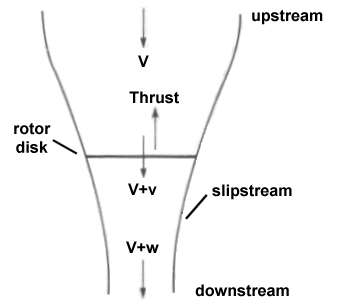|
||||||||||
|
|
||||||||||
|
||||||||||
|
|
||||||||||
Unfortunately, there is no simple equation to compute the lift generated by a helicopter rotor in hover like there is for forward flight. Instead, we must rely on substantially more complicated methods like the Blade Element Momentum Theory or the Actuator Disk Vortex Theory. Both approaches involve complex jargon and even more complex mathematics that would require far more explanation than we have the time or space to discuss here (to emphasize the point, I have a 1,000 page book on the subject of helicopter theory!). In either case, we are not concerned with computing the lift so much as we are the power required to maintain hover and the thrust force generated by the rotor.

In order to generate this thrust, the rotor pulls air down through it, as illustrated above, acting just like
an airplane propeller that has been turned 90°. The spinning rotor accelerates the air as it goes through the
rotor disk creating a force that acts in the opposite direction. This upward force is the rotor thrust. If you
think about it, since this "thrust" points straight up and is the only force counteracting the weight of the
helicopter, this force is the lift.
- answer by Jeff Scott, 29 July 2001
Read More Articles:


|
Aircraft | Design | Ask Us | Shop | Search |

|
|
| About Us | Contact Us | Copyright © 1997- | |||
|
|
|||